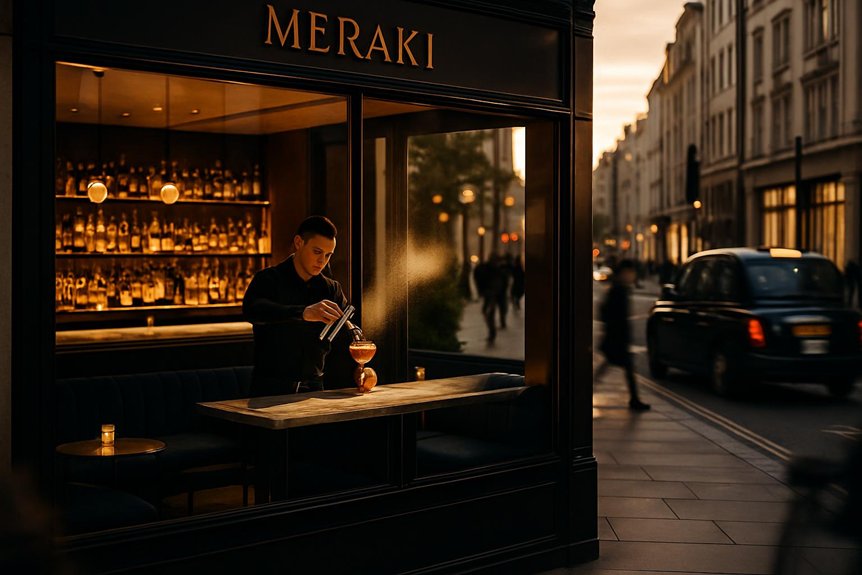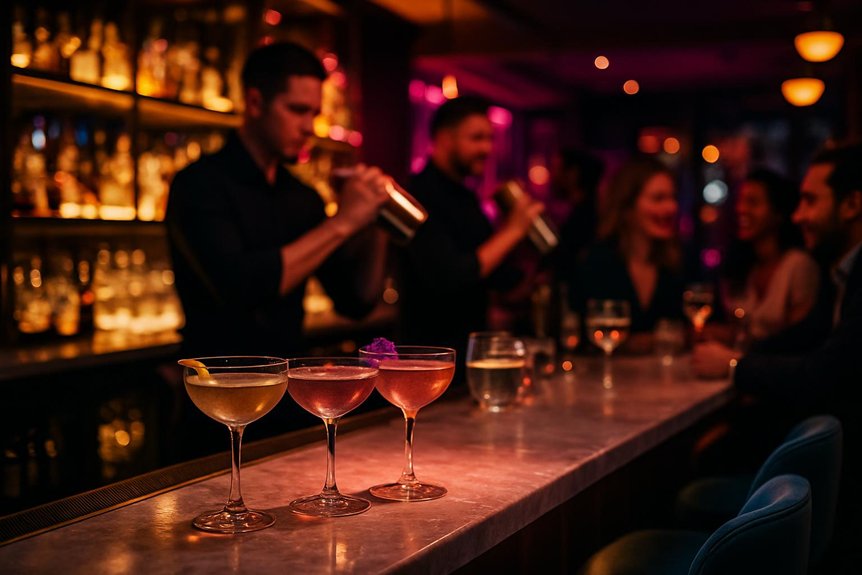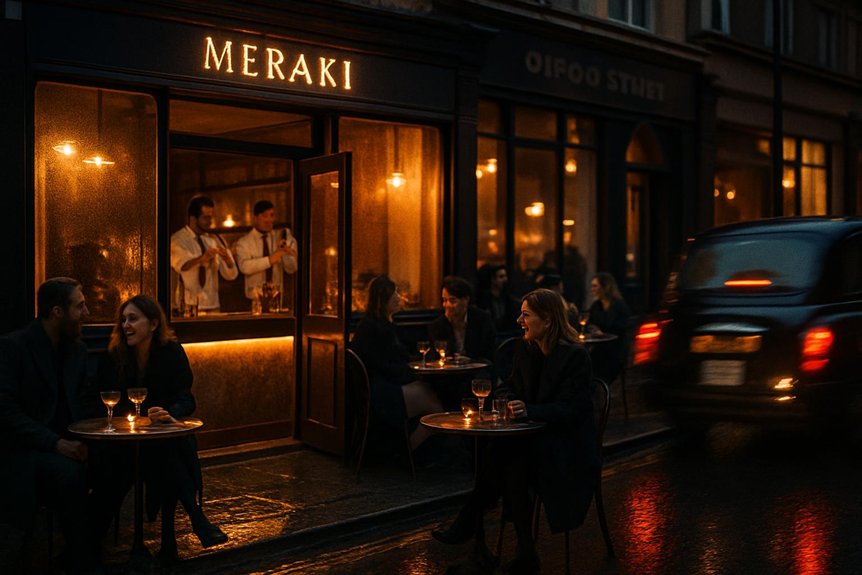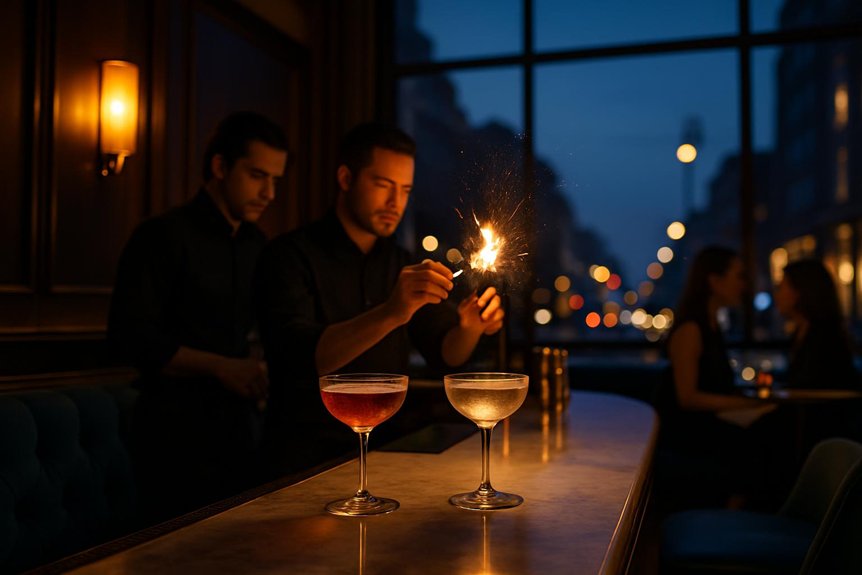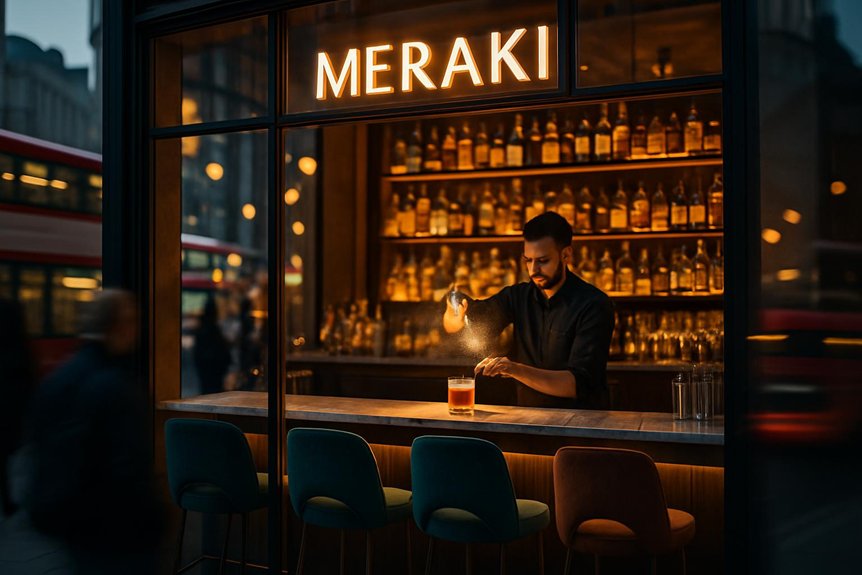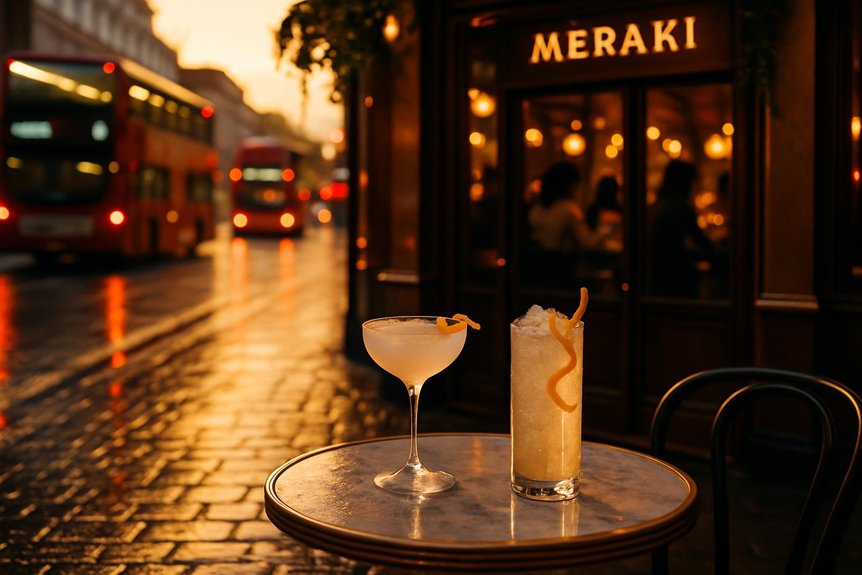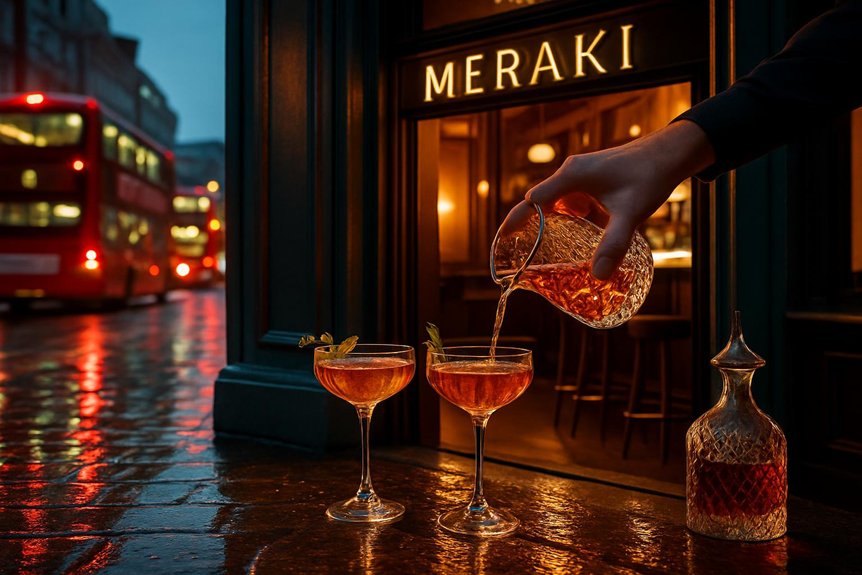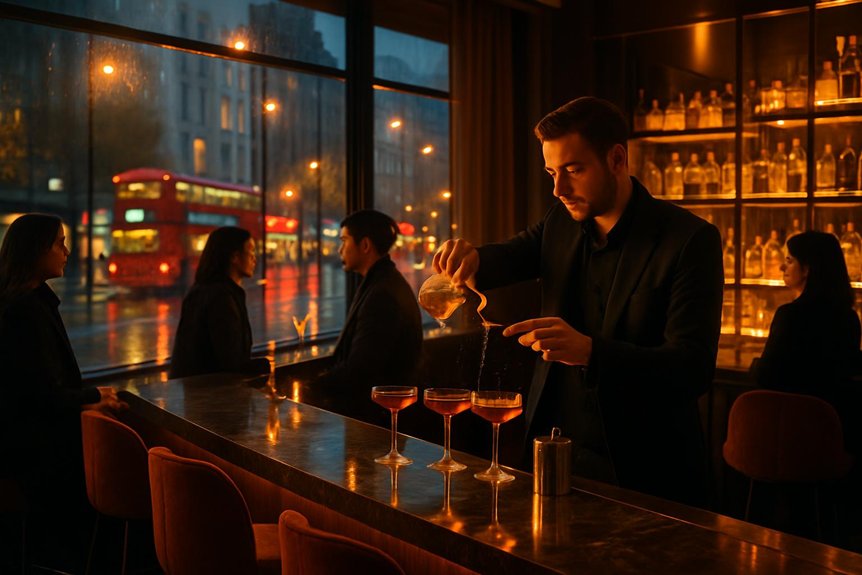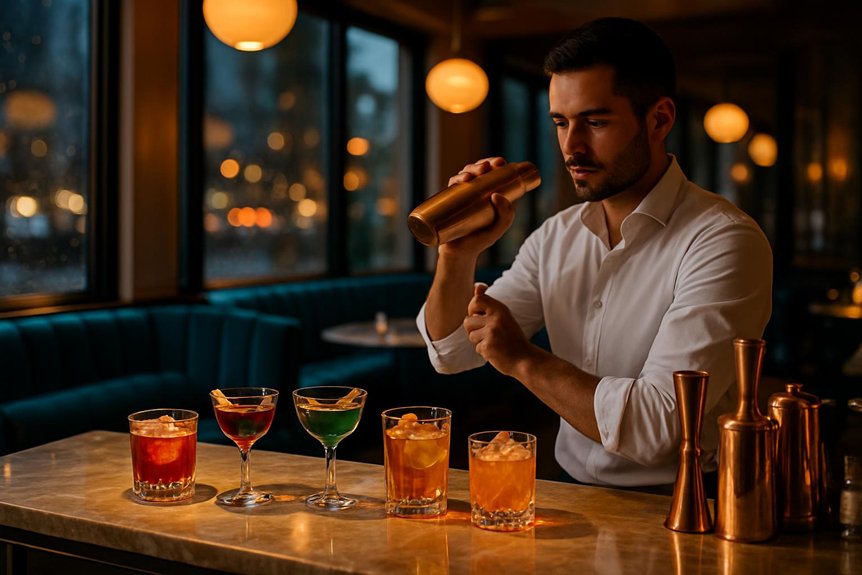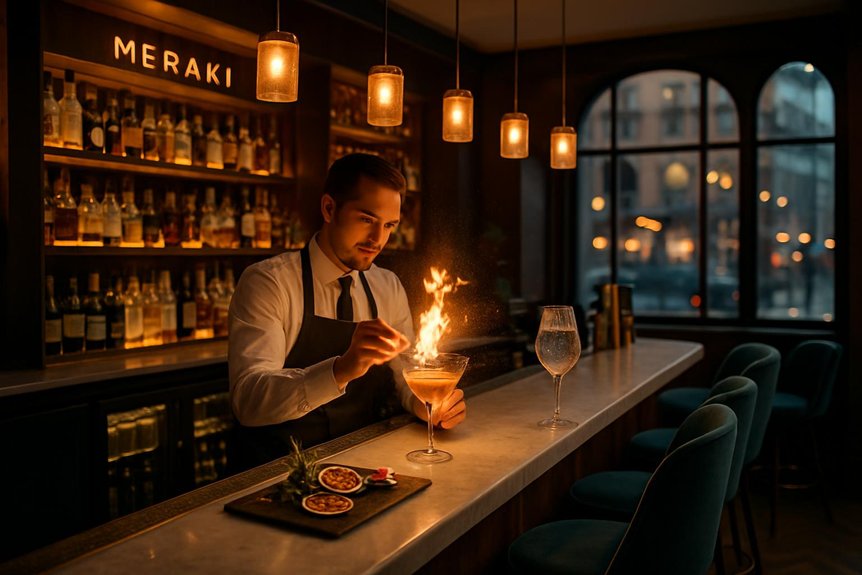Meraki sits a few steps from Oxford Street, turning retail rush into quiet ritual. The façade hints at night ahead; inside, low light and Mediterranean textures soften the city’s edge. Greek-leaning plates meet West End polish, and the bar shapes classics with a London accent. Service is measured, presentation sharp, and the room welcomes both pre-theatre pauses and late arrivals. What happens when the lights drop further is where its intent becomes clear.
From Oxford Street’s Buzz to Meraki’s Glow
How does the frenetic tide of Oxford Street give way to Meraki’s softer glow? Observers note a shift as crowds peel away from flagship windows and billboards into calmer side streets. Street fashion sets the tempo outside—sneakers, tailored coats, quick flashes of color—while a more measured rhythm awaits beyond Meraki’s threshold.
The city’s push for urban greening lends relief: pocket planters, young trees, and softened pavements temper the retail glare and guide footsteps toward quieter light. Inside, the sensory volume lowers. Conversations gather rather than spill, and lighting trims the day’s excess. The progression feels curated: energetic commerce dissolves into composed hospitality.
Without abandoning Oxford Street’s pulse, Meraki offers a focused counterpart, where momentum is retained but re-framed into poise, intention, and lingering time. Experience a vibrant atmosphere at Meraki Restaurant, where dining and dancing blend seamlessly for an unforgettable nightlife experience.
A Mediterranean Heart With West End Style
Meraki frames Greek flavors with a distinctly London flair, balancing tradition and trend. Sunlit dining sets a bright tone for mezzes and seafood, while clean lines and soft hues keep the room modern. As night falls, the buzz rises, and cocktails carry the Mediterranean heart into West End style. The Mediterranean Sunset, a signature cocktail at Meraki, epitomizes the blend of innovative mixology with traditional flavors, highlighting their commitment to creativity and sustainability.
Greek Flavors, London Flair
Why does a plate of grilled octopus taste different when seasoned with Aegean restraint and served beneath Soho’s neon? At Meraki, the answer sits between Greek heritage and London style. The kitchen respects simplicity—olive oil that tastes of hillside groves, oregano dried under island sun, lemons cut for brightness rather than shock—yet edits it with urban precision.
Tarama is whipped silk-light, then paired with crisp crudités for a metropolitan snap. Lamb is charred to a maritime smokiness, but plated with painterly economy. Tomatoes arrive at peak ripeness, amplified by capers, not cloaked by sauces. Cocktails echo the pantry—mastiha, thyme, citrus—structured with bartender rigor. The extensive wine menu at Meraki prioritizes Greek wines, offering a curated experience that complements the distinct Mediterranean flavors.
The result is a dialect of flavor: clear, modern, and unmistakably Mediterranean, articulated in the cadence of the West End.
Sunlit Dining, Night Buzz
Daylight catches on whitewashed brick and brass, carrying the same clean flavors into a room that feels part Aegean courtyard, part West End stage. At lunch, the pace is unhurried; glassware glints, olive oil glows, and citrus edges the air. Servers move with calm precision, letting the menu’s coastal brightness speak. It’s sunlit bliss without showmanship.
As shadows lengthen, tempo rises. Candles replace glare, playlists sharpen, and the bar asserts its angle on London ritual. The Greek heart stays steady—grilled octopus, oregano smoke—while the West End adds nightlife polish.
Bartenders pivot from spritzes to stirred and serious, drawing in pre-theatre crowds and late stragglers. By midnight, the room hums with night buzz, an elegant tide meeting Oxford Street’s current.
Elevated Mezze for the Modern Palate
Meraki frames mezze around seasonal Mediterranean produce, letting peak-market vegetables and herbs set the tone.
Creative sharing plates rework familiar forms—crisp textures, charcoal notes, and bright acids invite a communal pace. Artful dips and spreads anchor the table, balancing silky tahini, strained yogurt, and olive oil with precise spice and citrus.
Seasonal Mediterranean Produce
The menu’s heart beats with seasonal Mediterranean produce, translating market freshness into elevated mezze for a contemporary palate. Anchored in local harvest cycles, the kitchen treats vegetables, grains, and seafood as time-stamped expressions of place.
Crisp fennel, charred peppers, and early tomatoes arrive with restrained technique and deliberate flavor layering, ensuring clarity of taste over ornament.
1) Spring signals tender artichokes with lemon oil and mint salt; acidity and herb lift deliver clean definition.
2) Summer focuses on heirloom tomatoes, olive brine, and basil seeds, where salinity meets gentle sweetness and textural snap.
3) Autumn turns to roasted squash, smoked yogurt, and sesame, balancing caramelized depth with lactic brightness.
The result is mezze that reads as seasonal snapshots—concise, vivid, and confidently modern.
Creative Sharing Plates
A menu of creative sharing plates reframes mezze as composed, collaborative bites built for easy circulation across the table. The kitchen treats small plates as a canvas, leaning on plating artistry to guide the eye and pace the meal. Vegetables are charred, pickled, or briefly cured, then paired with seafood or heritage meats to create contrast without clutter. Fusion flavors appear as subtle bridges—citrus-smoked paprika with octopus, oregano-honey lacquer on quail, or tahini brightened by yuzu over roasted squash.
Textures are engineered to land in sequence: crisp, tender, silky, then a clean finish. Portions arrive staggered, encouraging conversation and spontaneous pairing with cocktails.
Each plate feels complete on its own yet designed to interlock, revealing a modern, sociable reading of mezze.
Artful Dips and Spreads
Against a backdrop of marble and brass, bowls of whipped, jeweled spreads deliver elegance without excess. The kitchen treats mezze as composition, not garnish, calibrating texture and salinity to achieve flavor harmony.
Each dip favors clarity: a bright acid, a grounded earth note, a clean finish. In this setting, mediterranean culture appears refined yet intact, translated for Oxford Street without losing its coastal pulse.
1) Smoked aubergine with tahini and lemon: silk-smooth, lifted by pomegranate, finished with chili oil for measured heat.
2) Feta mousse with wild thyme honey: aerated, saline-sweet, punctuated by toasted sesame and citrus zest for snap.
3) Chickpea crema with preserved lemon: ultra-fine, olive oil-lustrous, scattered with herbs and green pistachio for gentle crunch.
Warm flatbreads arrive precisely timed, ensuring temperature and texture align.
Signature Cocktails With a London Twist
From Soho lounges to tucked-away hotel bars, signature cocktails here wear a distinctly London accent: juniper-forward gins, marmalade bitters, Earl Grey infusions, and a whisper of smoke from peated spirits.
Bartenders lean on hedgerow fruits, heather honey, and zesty lemon oils, balancing brisk tannins with restrained sweetness. A Martini is trimmed with saline and bergamot; a Collins trades sugar for quince cordial; a Penicillin variant slips in Lapsang syrup for tea-steeped depth.
Local palates shape dessert pairings: citrus tarts meet chamomile spritzes, sticky toffee pudding matches sherry-and-walnut Old Fashioneds, and chocolate fondants find lift in fennel-tinged Negronis.
Mocktail innovations mirror the same rigor—cold-brew tea highballs, smoke-free peat illusions via roasted barley, and zero-proof bitters that keep structure without compromise.
Low-Lit Corners and Late-Night Allure
How does Oxford Street’s after-hours pulse find its quiet echo in the city’s bars? Observers note a dusk ambiance that softens neon glare into velvet shadow, where conversation lowers and silhouettes anchor the room.
Low-lit corners become staging grounds for confidences, and hidden nooks offer privacy without isolation. The tempo slows, yet intention sharpens; the scene edits itself to essentials: light, hush, and glass.
- Lighting: Pools of amber and indigo guide focus, leaving margins suggestive; the eye completes what the room withholds.
- Acoustics: Thick fabrics and close walls temper sound, shaping murmurs into a steady undertow that flatters quiet talk.
- Spatial choreography: Banquettes, screens, and side corridors structure encounters, encouraging brief crossings, extended pauses, and unhurried departures.
Pairing Plates With Pour-Over Precision
As the room settles into its hush, attention turns to what sits beside the glass. Plates arrive measured and deliberate, each bite composed to echo or counterpoint what’s poured with pour-over precision.
The kitchen tracks seasonal flavor with quiet rigor: citrus brightens raw fish, char and smoke frame late-harvest roots, while herbs thread the middle distance between sweetness and salinity.
A disciplined beverage pairing guides the cadence. Light, mineral-driven sips lift saline starters; bitter-leaning infusions tether rich textures; a restrained fizz cleanses between spice and fat.
Nothing shouts—acidity, temperature, and aroma act as signals rather than spectacle. Courses move like movements in a score, each sip tightening focus, each plate answering.
Balance is the thesis; memory, the gentle coda.
Pre-Theatre Sips and Post-Shop Soirées
Before curtains rise or shopping bags bite into fingers, the bar becomes a waypoint—swift, deft, and quietly polished. Patrons arrive with agendas: a bracing aperitif, a short pause to recalibrate, then onward to stages and streets. Glassware clicks like metronomes; conversation keeps brisk time, unencumbered by ceremony.
They move between textures of evening: lean spritzes, low-proof tonics, and measured classics sized for punctual exits. After performances and purchases, the pace loosens; booths gather friends, and a late menu steadies the night. Pool tables hum at the periphery, and curated wine tastings offer soft landings.
- Timing dictates pour size, garnish restraint, and check speed.
- Seating subtly shapes tempo—barstool dash versus booth linger.
- Transitional menus prioritize clarity, refreshment, and reliable finish.
Inside the Bar: Craft, Technique, Theatre
Where does the illusion begin—at the ice, the wrist, or the quiet arithmetic of dilution? Behind Meraki’s bar, precision frames the spectacle.
Spirits are measured, chilled, and moved with economy; the shaker speaks in clipped rhythms, the jigger answers in milliliters. Bartender techniques act like choreography: a controlled whip shake for aeration, a hard shake for texture, a stir that polishes rather than agitates.
Heat exchange is timed, not guessed.
Glassware signals intent. Frosted Nick and Nora for clarity, heavy rocks for structure.
Citrus oils are expressed to a line of light, not a flourish.
The cocktail presentation is restrained yet cinematic: clean rims, tight garnishes, quiet color contrasts. Nothing is ornamental without purpose; every detail serves balance, tempo, and recall.
Neighborhood Vibes, Destination Energy
Oxford Street sets the tone with its high-energy ambience, blending retail rush with urban polish. Bars sit within easy walking distance, enabling a seamless cocktail crawl across styles and moods.
As daylight shifts to neon, the area’s day-to-night buzz turns a quick stop into a destination.
Oxford Street Ambience
How does a mile of retail turn into a pulse that sets the pace for a city? Oxford Street’s urban ambiance registers first as sound: buses sighing, crosswalk clicks, snippets of multiple languages. The street scene is kinetic but legible, a grid of storefront glow and swift footsteps. Seasonal lights reframe the thoroughfare as a stage, while morning deliveries and late-evening window reflections bracket the day’s tempo.
Meraki observes the rhythm rather than interrupts it, reading the cues of movement, brightness, and pause.
1) Crowd dynamics: peak footfall layers haste with curiosity, creating alternating surges and eddies.
2) Visual cadence: signage, façades, and transit lines produce repeating patterns that calm the churn.
3) Micro-climates: breezeways, awnings, and side streets modulate sound, scent, and light, shaping dwell time.
Cocktail Crawl Proximity
From that measured street rhythm, the evening vector shifts toward apertifs and after-hours itineraries. Around Meraki, geography becomes strategy: a compact radius links marquee mixology rooms with intimate dens, enabling a seamless cocktail crawl without cab fares or clock-watching.
Wayfinding is legible—main arteries for quick hops, hidden alleyways for quiet detours—so groups can recalibrate between reservations with minimal friction.
Vintage lampposts mark thresholds where retail frontage yields to bar entrances, giving the neighborhood a navigational cadence. Distances remain walkable, letting palates progress from bitter to bright, stirred to shaken, with each venue offering a distinct signature.
The proximity breeds destination energy: spontaneous table swaps, bartenders trading recommendations, and a steady flow that keeps itineraries agile while maintaining a composed, cosmopolitan tempo.
Day-To-Night Buzz
By late afternoon, the district shifts from retail pulse to social hum, a steady build that reads on terraces, doorways, and dimly lit stairwells. The shift is measurable: footsteps slow, bags disappear under bar stools, and conversations lengthen.
Office lights recede while awnings extend, positioning the area between historic landmarks and the after-work orbit. Retail therapy cedes to glassware clink and low bass lines, a pragmatic handover rather than a spectacle.
- Transit cadence: commuters reroute toward side streets, compressing footfall into narrow corridors that feed notable cocktail rooms.
- Spatial layering: rooftops, speakeasies, and corner lounges stack experiences without breaking the street’s visual continuity.
- Time thresholds: golden hour favors aperitifs; twilight anchors reservations; night introduces late pours, drawing destination energy from beyond Oxford Street.
How to Book, When to Go, What to Order
Reservations reward foresight: peak evenings near Oxford Street fill swiftly, so securing a table at least a week ahead via the bar’s online system or a quick call is prudent. Practical reservation tips include noting terrace vs. counter preferences, confirming dietary needs, and setting an SMS reminder to avoid release of the hold. Walk-ins are possible early weekday evenings.
For best visiting times, late afternoons offer calmer service and quicker seats; post-theatre slots after 10 p.m. suit night owls. Fridays surge from 6–9 p.m., while Sundays are relaxed and neighborly.
Order strategically: begin with a bright, citrus-led signature to reset the palate, then move to a spirit-forward classic—think Martini or Negroni riff. Pair with mezze—grilled octopus or feta-loaded chips—and finish with a herbal digestif.
Conclusion
As closing time neared, a barback held up a citrus peel—thin as ribbon—measuring it like a tailor. It fit the glass perfectly. That single trim felt like Oxford Street meeting Meraki’s polish: bustle cut to shape, energy refined. One recent weekend, 70% of guests came from nearby shops or theatres, yet lingered past midnight. The metaphor holds—Meraki tailors the city’s fabric, hemming retail rush and stage-light shimmer into a cocktail hour that fits just right.

